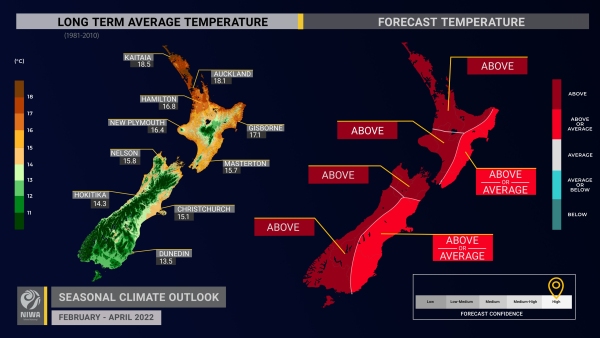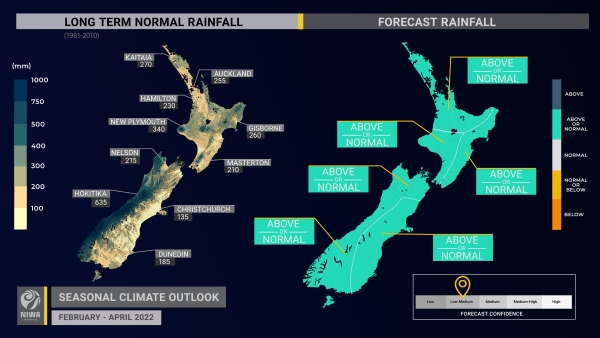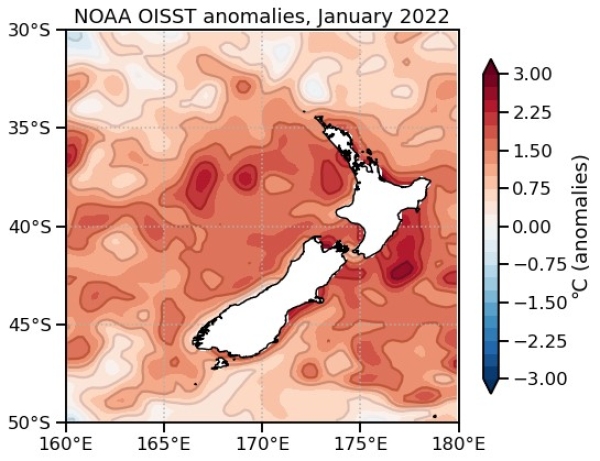Outlook summary
- La Niña conditions peaked in the equatorial Pacific during January, with a 75% chance for its continuation during the next three months. For more information, see the Background.
- Aotearoa New Zealand’s coastal waters continued to experience marine heatwave (MHW) conditions during January. Sea surface temperatures (SSTs) ranged from 0.9˚C to 1.9˚C above average. MHW conditions will continue to have an upward influence on air temperatures and humidity. Climate model guidance suggests the MHW will gradually ease during autumn.
- Air pressure is forecast to be higher than normal to the south of New Zealand and lower than normal to the north of the country. This is expected to be associated with easterly quarter wind flow anomalies, consistent with the continuation of La Niña and an elevated risk for atmospheric rivers and ex-tropical cyclones in the New Zealand region.
- Temperatures are likely to be warmer than average in all regions except for the east of both islands where average or above average temperatures are about equally likely. This will continue to influence periods of elevated humidity and warm overnight temperatures, though a reduction in westerlies may result in less hot days in the east.
- Rainfall is about equally likely to be near normal or above normal in all regions of the country. For the north and west of the South Island in particular, the seasonal rainfall signal will be influenced by a heavy rain event in early February, increasing the risk for flooding. Moderate-to-heavy rain may affect the North Island during the second week of the month.
- While high pressure and drier weather may return during the second half of February, another risk for heavy rainfall may arise in March.
- As of late January, NIWA’s New Zealand Drought Index indicated that extremely dry conditions were occurring in several regions. Meteorological drought had developed in parts of Northland and Waikato.
- There is an elevated risk for atmospheric river and ex-tropical cyclone activity around New Zealand in the coming months. These systems can bring heavy rainfall and increase the risk for flooding. Weather-sensitive groups should keep a close eye on day-to-day forecasts.
- Soil moisture levels and river flows are most likely to be near normal in all regions of the country for the three months as a whole, although substantial deficits were occurring in some regions as of late January. Heavy rainfall events can lead to abrupt and rapid increases in river flows and soil moisture.
Ben Noll (Meteorologist/Forecaster) and Chris Brandolino (Principal Scientist - Forecasting and Media) present the February - April 2022 Seasonal Climate Outlook in detail:


Regional predictions for February – April 2022
Northland, Auckland, Waikato, Bay of Plenty
The table below shows the probabilities (or percent chances) for each of three categories: above average, near average, and below average. In the absence of any forecast guidance there would be an equal likelihood (33% chance) of the outcome being in any one of the three categories. Forecast information from local and global guidance models is used to indicate the deviation from equal chance expected for the coming three-month period, with the following outcomes the most likely (but not certain) for this region:
- Temperatures are very likely to be above average (70% chance). Due to marine heatwave conditions, periods of excessive humidity and hot temperatures are likely to continue.
- Rainfall totals are about equally likely to be near normal (40% chance) or above normal (35% chance).
- An elevated chance for atmospheric rivers and ex-tropical cyclone activity may increase the risk for heavy rainfall events; however, extended dry spells will also continue to be possible.
- In late January, extremely dry conditions were occurring in parts of Northland, Auckland, Waikato, and western Bay of Plenty according to NIWA’s New Zealand Drought Index. Meteorological drought had developed in parts of Northland and Waikato.
- Soil moisture levels and river flows are most likely to be near normal (45% chance).
The full probability breakdown is:
|
Temperature |
Rainfall |
Soil moisture |
River flows |
|
|
Above average |
70 |
35 |
25 |
25 |
|
Near average |
25 |
40 |
45 |
45 |
|
Below average |
05 |
25 |
30 |
30 |
Central North Island, Taranaki, Whanganui, Manawatu, Wellington
Probabilities are assigned in three categories: above average, near average, and below average.
- Temperatures are very likely to be above average (70% chance). Due to marine heatwave conditions, periods of high humidity and hot temperatures are likely to continue.
- Rainfall totals are about equally likely to be near normal (40% chance) or above normal (35% chance).
- An elevated chance for atmospheric rivers and ex-tropical cyclone activity may increase the risk for heavy rainfall events; however, extended dry spells will also continue to be possible.
- In late January, very dry conditions were occurring about inland Manawatu-Whanganui according to NIWA’s New Zealand Drought Index.
- Soil moisture levels and river flows are most likely to be near normal (50% chance).
The full probability breakdown is:
|
Temperature |
Rainfall |
Soil moisture |
River flows |
|
|
Above average |
70 |
35 |
25 |
25 |
|
Near average |
25 |
40 |
50 |
50 |
|
Below average |
05 |
25 |
25 |
25 |
Gisborne, Hawke’s Bay, Wairarapa
Probabilities are assigned in three categories: above average, near average, and below average.
- Temperatures are about equally likely to be above average (50% chance) or near average (45% chance). Due to marine heatwave conditions, periods of high humidity and warm overnight temperatures are likely. A reduction in westerly winds may lead to less hot days than normal, however.
- Rainfall totals are about equally likely to be near normal (40% chance) or above normal (35% chance).
- An elevated chance for atmospheric rivers and ex-tropical cyclone activity may increase the risk for heavy rainfall events; however, extended dry spells will also continue to be possible.
- In late January, abnormally dry conditions were occurring across the region according to NIWA’s New Zealand Drought Index.
- Soil moisture levels and river flows are most likely to be near normal (50% chance).
The full probability breakdown is:
|
Temperature |
Rainfall |
Soil moisture |
River flows |
|
|
Above average |
50 |
35 |
20 |
20 |
|
Near average |
45 |
40 |
50 |
50 |
|
Below average |
05 |
25 |
30 |
30 |
Tasman, Nelson, Marlborough, Buller
Probabilities are assigned in three categories: above average, near average, and below average.
- Temperatures are likely to be above average (55% chance). Due to marine heatwave conditions, periods of high humidity and hot temperatures are more likely.
- Rainfall totals are equally likely to be near normal (40% chance) or above normal (40% chance).
- An elevated chance for atmospheric rivers and ex-tropical cyclone activity may increase the risk for heavy rainfall events, such as during the first week of February when flooding is possible. However, periods of high pressure may also cause extended dry spells.
- In late January, abnormally dry conditions were occurring across the region according to NIWA’s New Zealand Drought Index.
- Soil moisture levels and river flows are most likely to be near normal (55% chance).
The full probability breakdown is:
|
Temperature |
Rainfall |
Soil moisture |
River flows |
|
|
Above average |
55 |
40 |
20 |
20 |
|
Near average |
40 |
40 |
55 |
55 |
|
Below average |
05 |
20 |
25 |
25 |
West Coast, Alps and foothills, inland Otago, Southland
Probabilities are assigned in three categories: above average, near average, and below average.
- Temperatures are very likely to be above average (65% chance). More frequent offshore winds may increase the frequency of hot days along the West Coast.
- Rainfall totals are equally likely to be near normal (40% chance) or above normal (40% chance).
- An elevated chance for atmospheric rivers and ex-tropical cyclone activity may increase the risk for heavy rainfall events, such as during the first week of February when flooding is possible. However, periods of high pressure may also cause extended dry spells.
- In late January, very dry conditions were occurring in central and southern Otago, eastern Southland, and Stewart Island according to NIWA’s New Zealand Drought Index.
- Soil moisture levels and river flows are most likely to be near normal (50% chance).
The full probability breakdown is:
|
Temperature |
Rainfall |
Soil moisture |
River flows |
|
|
Above average |
65 |
40 |
30 |
30 |
|
Near average |
30 |
40 |
50 |
50 |
|
Below average |
05 |
20 |
20 |
20 |
Coastal Canterbury, east Otago
Probabilities are assigned in three categories: above average, near average, and below average.
- Temperatures are about equally likely to be above average (50% chance) or near average (45% chance). Due to marine heatwave conditions, periods of high humidity and warm overnight temperatures are likely. A reduction in westerly winds may lead to less hot days than normal, however.
- Rainfall totals are about equally likely to be near normal (40% chance) or above normal (35% chance). Predominant onshore winds may influence more cloud cover and drizzle.
- Soil moisture levels and river flows are most likely to be near normal (50% chance).
The full probability breakdown is:
|
Temperature |
Rainfall |
Soil moisture |
River flows |
|
|
Above average |
50 |
35 |
20 |
20 |
|
Near average |
45 |
40 |
50 |
50 |
|
Below average |
05 |
25 |
30 |
30 |
Graphical representation of the regional probabilities

Background
The NINO3.4 Index anomaly (in the central Pacific) over the last month (through 30 January) was -0.70˚C, on the La Niña threshold. The January monthly Southern Oscillation Index (SOI) was +0.3 and the November-January three-month average SOI was +0.9, the latter near the La Niña threshold.
In the subsurface equatorial Pacific, a substantial warm pool (+2˚C to +3˚C) at around 150 m depth continued to progress eastward from the western Pacific, which indicated an ongoing, gradual decay of La Niña. This was associated with a downwelling oceanic Kelvin Wave, which by late January had reached 150W-140W (central Pacific). Closer to the surface and in the east, La Niña’s cool pool persisted and will likely linger for a few more months.
La Niña conditions are expected to continue during February-April (75% chance). Between May-July, there is a 65% chance for the re-emergence of ENSO neutral conditions. During August-October, ENSO neutral is favoured at a 50% chance.
During January, convective forcing focused over the Maritime Continent and central and western Pacific. This was influenced by several modes of variability. Convective forcing associated with La Niña will be active over the western Pacific during the first half of February, influencing the development of an atmospheric river and the potential for regional tropical cyclone activity.
The active phase of the Madden-Julian Oscillation (MJO) over the eastern Indian Ocean and Maritime Continent (north of Australia) during the second half of February may be associated with a trend toward more high pressure and lower chances for rainfall around New Zealand from the middle part of the month onward.
This forcing pattern most resembles MJO phases 3 and 4. Historically during these phases, temperatures have been warmer than average and above normal rainfall has occurred in western areas during phase 3 with widespread dryness during phase 4 except in the northern North Island. This is aligned with the expectation for heavy rainfall in the western and northern South Island during the first week of the month.
Movement into the region of phases 5 and 6 during March may imply an increased chance for tropical cyclone activity and/or atmospheric rivers in the Southwest Pacific and resultant risk for heavy rainfall in parts of New Zealand.
The Southern Annular Mode (SAM) was predominantly positive in January. Looking ahead, the SAM is forecast to spend more time in its positive phase, with southerly fronts occurring infrequently.
New Zealand’s coastal waters continued to experience MHW conditions during January. SSTs were above to well above average in all regions, ranging from +0.9˚C to +1.9˚C above average. MHW conditions will continue to have an upward influence on air temperatures and humidity during February. Climate model guidance suggests the MHW will gradually ease during autumn.
New Zealand coastal SST anomalies (through to 30 January)
|
North NI |
1.62˚C |
|
West NI |
1.47˚C |
|
East NI |
1.90˚C |
|
North SI |
1.60˚C |
|
West SI |
0.86˚C |
|
East SI |
1.81˚C |

Forecast confidence
Temperature

|
Forecast confidence for temperatures is high. The continuation of marine heatwave and La Niña conditions are expected to have an upward influence on air temperatures and humidity. A reduction in westerly winds may lead to fewer hot days in the east of both islands, however. Most of the climate models that NIWA surveys indicate a warmer than average February-April. |
Rainfall
 |
Forecast confidence for rainfall is low to medium. The risk for atmospheric rivers and ex-tropical cyclone activity around New Zealand will be elevated in the coming months, but the exact track of such systems cannot be determined so far in advance. New Zealanders should remain vigilant for local impacts (e.g., heavy rainfall / flooding). One of these systems can quickly change the complexion of a season, but if the track occurs just offshore, dryness may be reinforced. |

